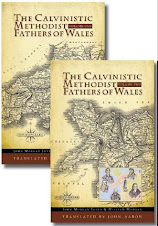31 Jan 2023
28 Mar 2021
The Established Church
These words are found in The Life and Speeches of the Very Rev. J. H. Cotton ...
I was in union with the Established Church and with the Calvinistic Methodist body and the Methodist Deacons were grumbling rather and wanted me to stand by either of the two and sever my connection with the other. I had some hestitation about this subsequently Mr Elias was to preach here on a Sunday and on Saturday the 7th of May 1840 I started to meet him for the purpose of having his opinion and advice on my case And this is what he said 'Never separate from the Communion of the Established Church nevertheless you can be in connection with us because we are a branch of the Church These are his words word for word'.
Transmission of Biblical Visual Imagery in Calvinistic Methodism
This paragraph is from an essay by D Huw Owen on The Transmission of Biblical Visual Imagery in Calvinistic Methodism/Presbyterian Church of Wales
Hugh Hughes had moved to Caernarfon by 1835, and William Roos, a native of Amlwch, had already moved there, as in the previous year he had advertised his availability as a portrait painter. Caernarfon developed into an important centre for artisan painters, with several of them competing with Hugh Hughes for commissions from the middle class. William Roos claimed that he had completed a portrait of John Elias in 1839, the same year as Hugh Jones's famous portrait of the renowned preacher. An engraving of this portrait was commissioned in 1840, probably on account of the connection between William Jones, the portrait painter from Chester and the artist's brother, and the publisher Edward Parry. This portrait, the basis for Samuel Benin's engraving published by Edward Parry in Chester, became a very popular icon in Wales, as also was the one of Christmas Evans, the Baptist leader, painted by William Roos in 1835. It is uncertain whether an engraved version of William Roos's portrait of John Elias was based on an oil painting by him, either the alleged one in 1839, another one in 1841 or a copy of Hugh Jones's work. The suggestion has been made that this engraving was the basis of the Staffordshire figure of John Elias, which, together with those of Christmas Evans and John Bryan, the eminent Baptist and Wesleyan Methodist preachers, were extremely popular. William Roos also produced in the 1830s an oil painting based on Hugh Hughes's portrait of 1812, but influenced by Bailey's engraving of 1838.










